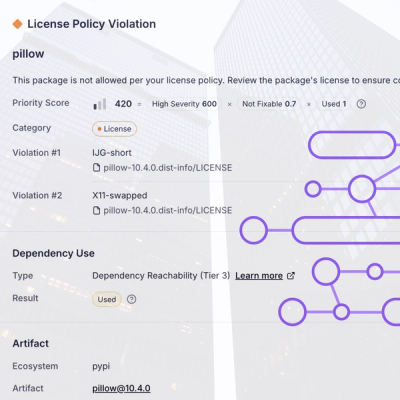
Research
/Security News
Critical Vulnerability in NestJS Devtools: Localhost RCE via Sandbox Escape
A flawed sandbox in @nestjs/devtools-integration lets attackers run code on your machine via CSRF, leading to full Remote Code Execution (RCE).
The Independent Marketing Sciences package is a Python library designed to process incoming data into a format tailored for projects, particularly those utilising weekly time series data. This package offers a suite of functions for efficient data collection, manipulation, visualisation and analysis.
from imsciences import dataprocessing, geoprocessing, datapull, datavis
ims_proc = dataprocessing()
ims_geo = geoprocessing()
ims_pull = datapull()
ims_vis = datavis()
get_wd_levelsget_wd_levels(levels)get_wd_levels(0)aggregate_daily_to_wc_longaggregate_daily_to_wc_long(df, date_column, group_columns, sum_columns, wc, aggregation='sum')aggregate_daily_to_wc_long(df, 'date', ['platform'], ['cost', 'impressions', 'clicks'], 'mon', 'average')convert_monthly_to_dailyconvert_monthly_to_daily(df, date_column, divide=True)convert_monthly_to_daily(df, 'date')week_of_year_mappingweek_of_year_mapping(df, week_col, start_day_str)week_of_year_mapping(df, 'week', 'mon')rename_colsrename_cols(df, name='ame_')rename_cols(df, 'ame_facebook')merge_new_and_oldmerge_new_and_old(old_df, old_col, new_df, new_col, cutoff_date, date_col_name='OBS')merge_new_and_old(df1, 'old_col', df2, 'new_col', '2023-01-15')merge_dataframes_on_columnmerge_dataframes_on_column(dataframes, common_column='OBS', merge_how='outer')merge_dataframes_on_column([df1, df2, df3], common_column='OBS', merge_how='outer')merge_and_update_dfsmerge_and_update_dfs(df1, df2, key_column)merge_and_update_dfs(processed_facebook, finalised_meta, 'OBS')convert_us_to_uk_datesconvert_us_to_uk_dates(df, date_col)convert_us_to_uk_dates(df, 'date')combine_sheetscombine_sheets(all_sheets)combine_sheets({'Sheet1': df1, 'Sheet2': df2})pivot_tablepivot_table(df, index_col, columns, values_col, filters_dict=None, fill_value=0, aggfunc='sum', margins=False, margins_name='Total', datetime_trans_needed=True, reverse_header_order=False, fill_missing_weekly_dates=False, week_commencing='W-MON')pivot_table(df, 'OBS', 'Channel Short Names', 'Value', filters_dict={'Master Include': ' == 1'}, fill_value=0)apply_lookup_table_for_columnsapply_lookup_table_for_columns(df, col_names, to_find_dict, if_not_in_dict='Other', new_column_name='Mapping')apply_lookup_table_for_columns(df, col_names, {'spend': 'spd'}, if_not_in_dict='Other', new_column_name='Metrics Short')aggregate_daily_to_wc_wideaggregate_daily_to_wc_wide(df, date_column, group_columns, sum_columns, wc='sun', aggregation='sum', include_totals=False)aggregate_daily_to_wc_wide(df, 'date', ['platform'], ['cost', 'impressions'], 'mon', 'average', True)merge_cols_with_seperatormerge_cols_with_seperator(df, col_names, separator='_', output_column_name='Merged')merge_cols_with_seperator(df, ['Campaign', 'Product'], separator='|', output_column_name='Merged Columns')check_sum_of_df_cols_are_equalcheck_sum_of_df_cols_are_equal(df_1, df_2, cols_1, cols_2)check_sum_of_df_cols_are_equal(df_1, df_2, 'Media Cost', 'Spend')convert_2_df_cols_to_dictconvert_2_df_cols_to_dict(df, key_col, value_col)convert_2_df_cols_to_dict(df, 'Campaign', 'Channel')create_FY_and_H_columnscreate_FY_and_H_columns(df, index_col, start_date, starting_FY, short_format='No', half_years='No', combined_FY_and_H='No')create_FY_and_H_columns(df, 'Week', '2022-10-03', 'FY2023', short_format='Yes')keyword_lookup_replacementkeyword_lookup_replacement(df, col, replacement_rows, cols_to_merge, replacement_lookup_dict, output_column_name='Updated Column')keyword_lookup_replacement(df, 'channel', 'Paid Search Generic', ['channel', 'segment'], lookup_dict, output_column_name='Channel New')create_new_version_of_col_using_LUTcreate_new_version_of_col_using_LUT(df, keys_col, value_col, dict_for_specific_changes, new_col_name='New Version of Old Col')create_new_version_of_col_using_LUT(df, 'Campaign Name', 'Campaign Type', lookup_dict)convert_df_wide_2_longconvert_df_wide_2_long(df, value_cols, variable_col_name='Stacked', value_col_name='Value')convert_df_wide_2_long(df, ['col1', 'col2'], variable_col_name='Var', value_col_name='Val')manually_edit_datamanually_edit_data(df, filters_dict, col_to_change, new_value, change_in_existing_df_col='No', new_col_to_change_name='New', manual_edit_col_name=None, add_notes='No', existing_note_col_name=None, note=None)manually_edit_data(df, {'col1': '== 1'}, 'col2', 'new_val', add_notes='Yes', note='Manual Update')format_numbers_with_commasformat_numbers_with_commas(df, decimal_length_chosen=2)format_numbers_with_commas(df, decimal_length_chosen=1)filter_df_on_multiple_conditionsfilter_df_on_multiple_conditions(df, filters_dict)filter_df_on_multiple_conditions(df, {'col1': '>= 5', 'col2': '== 'val''})read_and_concatenate_filesread_and_concatenate_files(folder_path, file_type='csv')read_and_concatenate_files('/path/to/files', file_type='xlsx')upgrade_outdated_packagesupgrade_outdated_packages(exclude_packages=['twine'])upgrade_outdated_packages(exclude_packages=['pip', 'setuptools'])convert_mixed_formats_datesconvert_mixed_formats_dates(df, column_name)convert_mixed_formats_dates(df, 'date_col')fill_weekly_date_rangefill_weekly_date_range(df, date_column, freq='W-MON')fill_weekly_date_range(df, 'date_col')add_prefix_and_suffixadd_prefix_and_suffix(df, prefix='', suffix='', date_col=None)add_prefix_and_suffix(df, prefix='pre_', suffix='_suf', date_col='date_col')create_dummiescreate_dummies(df, date_col=None, dummy_threshold=0, add_total_dummy_col='No', total_col_name='total')create_dummies(df, date_col='date_col', dummy_threshold=1)replace_substringsreplace_substrings(df, column, replacements, to_lower=False, new_column=None)replace_substrings(df, 'text_col', {'old': 'new'}, to_lower=True, new_column='updated_text')add_total_columnadd_total_column(df, exclude_col=None, total_col_name='Total')add_total_column(df, exclude_col='date_col')apply_lookup_table_based_on_substringapply_lookup_table_based_on_substring(df, column_name, category_dict, new_col_name='Category', other_label='Other')apply_lookup_table_based_on_substring(df, 'text_col', {'sub1': 'cat1', 'sub2': 'cat2'})compare_overlapcompare_overlap(df1, df2, date_col)compare_overlap(df1, df2, 'date_col')week_commencing_2_week_commencing_conversion_isoweekdayweek_commencing_2_week_commencing_conversion_isoweekday(df, date_col, week_commencing='mon')week_commencing_2_week_commencing_conversion_isoweekday(df, 'date_col', week_commencing='fri')seasonality_feature_extractionseasonality_feature_extraction(df, kpi_var, n_features=10, test_size=0.1, random_state=42, shuffle=False)seasonality_feature_extraction(df, 'kpi_total_sales', n_features=5, test_size=0.2, random_state=123, shuffle=True)pull_gapull_ga(credentials_file, property_id, start_date, country, metrics)pull_ga('GeoExperiment-31c5f5db2c39.json', '111111111', '2023-10-15', 'United Kingdom', ['totalUsers', 'newUsers'])process_itv_analysisprocess_itv_analysis(self, raw_df, itv_path, cities_path, media_spend_path, output_path, test_group, control_group, columns_to_aggregate, aggregator_list)process_itv_analysis(df, 'itv regional mapping.csv', 'Geo_Mappings_with_Coordinates.xlsx', 'IMS.xlsx', 'itv_for_test_analysis_itvx.csv', ['West', 'Westcountry', 'Tyne Tees'], ['Central Scotland', 'North Scotland'], ['newUsers', 'transactions'], ['sum', 'sum'])process_city_analysisprocess_city_analysis(raw_df, spend_df, output_path, test_group, control_group, columns_to_aggregate, aggregator_list)process_city_analysis(df, spend, output, ['Barnsley'], ['Aberdeen'], ['newUsers', 'transactions'], ['sum', 'sum'])plot_oneplot_one(df1, col1, date_column)plot_one(df, 'sales', 'date')plot_twoplot_two(df1, col1, df2, col2, date_column, same_axis=True)plot_two(df1, 'sales', df2, 'revenue', 'date', same_axis=False)plot_chartplot_chart(df, date_col, value_cols, chart_type='line', title='Chart', x_title='Date', y_title='Values')plot_chart(df, 'date', ['sales', 'revenue'], chart_type='line', title='Sales and Revenue')pull_fred_datapull_fred_data(week_commencing, series_id_list)pull_fred_data('mon', ['GPDIC1', 'Y057RX1Q020SBEA', 'GCEC1', 'ND000333Q', 'Y006RX1Q020SBEA'])pull_boe_datapull_boe_data(week_commencing)pull_boe_data('mon')pull_oecdpull_oecd(country='GBR', week_commencing='mon', start_date='2020-01-01')pull_oecd('GBR', 'mon', '2000-01-01')get_google_mobility_dataget_google_mobility_data(country, wc)get_google_mobility_data('United Kingdom', 'mon')pull_seasonalitypull_seasonality(week_commencing, start_date, countries)pull_seasonality('mon', '2020-01-01', ['US', 'GB'])pull_weatherpull_weather(week_commencing, start_date, country)pull_weather('mon', '2020-01-01', 'GBR')pull_macro_ons_ukpull_macro_ons_uk(additional_list, week_commencing, sector)pull_macro_ons_uk(['HBOI'], 'mon', 'fast_food')pull_yfinancepull_yfinance(tickers, week_start_day)pull_yfinance(['^FTMC', '^IXIC'], 'mon')pull_sports_eventspull_sports_events(start_date, week_commencing)pull_sports_events('2020-01-01', 'mon')Install the IMS package via pip:
pip install imsciences
This project is licensed under the MIT License.
FAQs
IMS Data Processing Package
We found that imsciences demonstrated a healthy version release cadence and project activity because the last version was released less than a year ago. It has 5 open source maintainers collaborating on the project.
Did you know?

Socket for GitHub automatically highlights issues in each pull request and monitors the health of all your open source dependencies. Discover the contents of your packages and block harmful activity before you install or update your dependencies.

Research
/Security News
A flawed sandbox in @nestjs/devtools-integration lets attackers run code on your machine via CSRF, leading to full Remote Code Execution (RCE).

Product
Customize license detection with Socket’s new license overlays: gain control, reduce noise, and handle edge cases with precision.

Product
Socket now supports Rust and Cargo, offering package search for all users and experimental SBOM generation for enterprise projects.